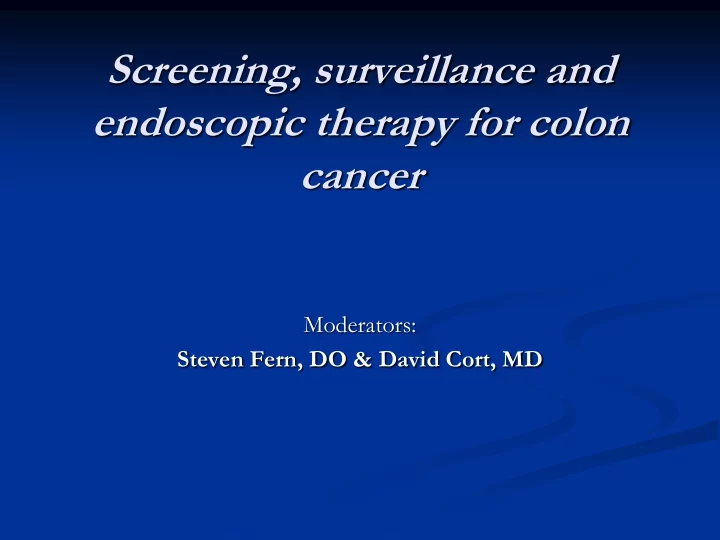

Screening, surveillance and endoscopic therapy for colon cancer Moderators: Steven Fern, DO & David Cort, MD
Panelists Steven H. Itzkowitz, MD David Lieberman, MD Professor of Medicine Professor of Medicine Associate Director, The Dr. Henry D. Chief, Division of Gastroenterology & Janowitz Division of Gastroenterology Hepatology Mount Sinai School of Medicine Oregon Health & Science University New York, NY Portland, OR Douglas K. Rex, MD Joel V. Brill, MD Professor of Medicine Chief Medical Officer of Predictive Health, Director of Endoscopy LLC Indiana University Assistant Clinical Professor of Medicine Indianapolis, IN University of Arizona School of Medicine Phoenix, AZ
Case 1 8 mm polyp in the sigmoid colon is removed with biopsy forceps. Biopsy shows adenocarcinoma AQ 1. Further management should include Immediately go back and tattoo 1. Colonoscopy in 3 months 2. Sigmoid resection 3. CT scan 4. EUS for evaluation of the site and possible EMR 5.
Case 2 3 cm sessile polyp (villous adenoma) in the rectosigmoid removed piecemeal with saline assisted polypectomy. Pathology: multiple areas of high-grade dysplasia and one small focus of invasive adenoCa invading the lamina propria AQ 2. Appropriate further management of this patient would be Repeat colonoscopy in 3 months 1. Low anterior resection 2. Transanal endoscopic Microdissection (TEM) 3. EUS evaluation for residual tumor/regional lymph nodes 4. CT abdomen and pelvis 5.
Case 3 3 cm pedunculated polyp in the transverse colon is removed with snare resection Pathology: invasive adenocarcinoma not reaching the stalk AQ 3. Appropriate further management of this patient would be Observation 1. Repeat colonoscopy in 3 months 2. Repeat colonoscopy in 1 year 3. Surgical resection 4. CT scan 5. Tattoo the polypectomy site 6.
Case 4 A 10 mm sessile polyp is noted in the cecum on a CTC performed after a failed colonoscopy. AQ 4. What to do next? Attempt colonoscopy by a “better” endoscopist 1. Review of CTC by a “better” radiologist 2. Repeat CTC in 3 months 3. Laparoscopic right colon resection 4. Repeat CTC in 1 year 5.
Case 5 65 year old woman with multiple medical problems but no family history of colon cancer undergoes screening colonoscopy after split dose colonic prep. Normal colonoscopy but has lot of liquid stool that cannot be entirely suctioned off AQ 5. Appropriate further management of this patient would be Repeat colonoscopy in 1-2 weeks 1. Repeat colonoscopy in 6 months 2. Repeat colonoscopy in 5 years 3. Repeat colonoscopy in 10 years 4.
Case 6 A 61 year old woman consults you about colon cancer screening. She avoided getting her screening colonoscopy at age 50 colonoscopy 20 years ago for LLQ pain (by another gastroenterologist) Difficult and painful colonoscopy due to sigmoid diverticulosis and adhesions from prior GYN surgery. She is not sure whether he reached the cecum, She thinks that he removed a "polyp". A repeat colonoscopy 5 years later again very difficult and associated with a fair amount of pain. She does not recall if any polyps were removed. She hates taking "that awful gallon of yucky liquid".
Case 6 (contd.) Her grandmother had CRC at age 82, but no other family history. She has put off any screening, but after the recent death of her closest friend to CRC, she became concerned. She has no GI symptoms. AQ 6. Which of the following would you advise? A. Colonoscopy with an easier prep and better sedation B. CT colonography C. Fecal immunochemical test D. Stool DNA test E. Flexible sigmoidoscopy plus FOBT
Question to Panel What are the issues with nurse administered propafol sedation for colonoscopy Do you foresee a significant future role for this
Question to Panel What is the added cancer risk due to radiation exposure with CTC
Question to Panel What is the CTC positivity rate in real world situations Conflict of interest in over-interpreting CT findings – Since radiologist are penalized for missing “lesions” but not for over-diagnosing How about the liability for missed extra-colonic lesions
Question to panel In clinical practice, what is the most appropriate way to use the commercially available molecular markers?
Goals and achievements of colon cancer screening program Potential benefits Potential costs Prevention of colon cancer Economic cost Reduction of colon cancer incidence noted in last 10 years Colonoscopy cost Early diagnosis of colon cancer use of anesthesia Stage migration noted in last 10 years follow up colonoscopies for benign polyps Use of newer improved technology endoscopes and devices Pathology cost Biopsying more and more polyps Use of special stains Cost of newer markers Cost of lost work Cost of managing complications Patient suffering Preparing for colonoscopy due to complications Anxiety in those found to have benign polyps Question to Panel • Is there a risk that the recent advances and developments in colon cancer screening will increase the costs to the point of making it cost-prohibitive? • Is there anything that can be done or is being done to prevent that situation?
Recommend
More recommend